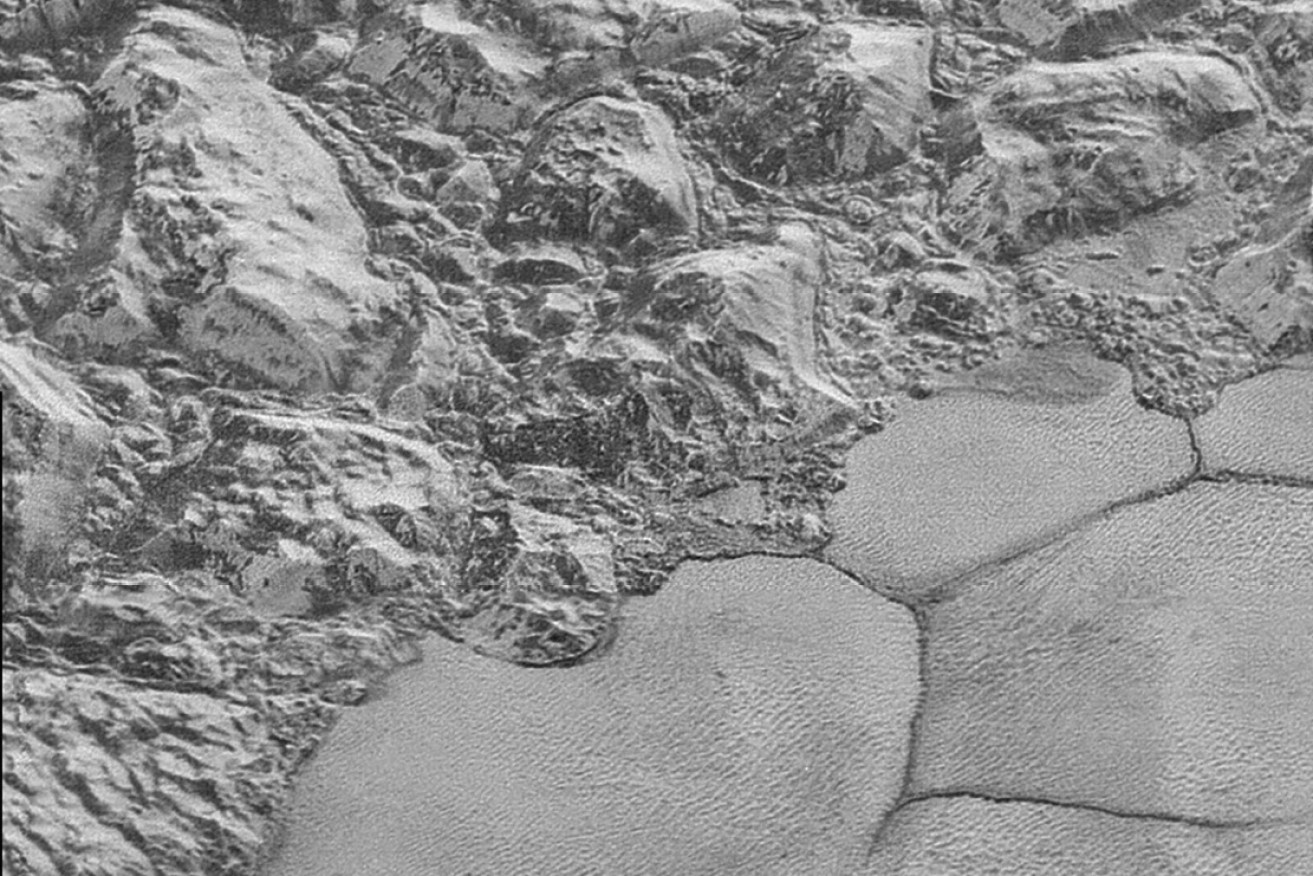Pluto’s dunes snapped by NASA’s New Horizons are made from frozen methane

A mountain range on Pluto's Sputnik Planitia ice plain, with dunes in the bottom half of the picture. Photo: AAP
For a minor planet, Pluto throws up some pretty big surprises. The icy world has dunes, but unlike Earth’s sandy versions, Pluto’s seem to be composed of flecks of methane ice.
Published on Friday in the journal Science, it’s the latest in a swag of new discoveries uncovered by NASA’s New Horizons spacecraft.
When New Horizons flew past Pluto in July 2015, it sent back detailed images of the icy world’s surface.
Matt Telfer at the University of Plymouth in the United Kingdom was one of many planetary scientists and geologists who scoured the pictures for interesting features such as dunes.
One location stood out: a north-west patch of Pluto’s vast heart-shaped plain of ice dubbed Tombaugh Regio.

When New Horizons whizzed by Pluto in 2015, it took detailed photos of the planet’s features. Photo: AAP
New Horizons took photos of dune-like ripples roughly a kilometre wide and tens of kilometres long on the plain, nestled against mountain peaks standing more than 3 kilometres tall.
“There were a few areas that looked interesting,” said Dr Telfer, who co-authored the paper.
“But this one spot, the more we looked at it, we thought ‘they really, really do look like dunes’.”
Upon closer examination, their location, orientation and spacing all pointed to them being dunes.
But there was a problem: planetary scientists thought Pluto’s atmosphere was too thin to sustain the winds needed to sculpt the ripples that were visible.
So how did they appear?
How to build a dune on Pluto
Think of dunes, and you probably picture sweeping swathes of hot sandy desert. Winds whisk sand grains into the air, which fall to the ground in ordered ridges.
On Earth, this happens largely because our atmosphere is thick enough to keep the wind blowing.
But Pluto has a comparatively thin atmosphere – only 0.001 per cent of what we have on Earth. Little atmosphere means weak winds.
So, armed with New Horizons data and some nifty modelling, Dr Telfer and his colleagues came up with an explanation that fit New Horizons’ pictures.
Pluto is extremely cold — around minus 230 degrees Celsius — and orbits the sun at an average distance of 6 billion kilometres.
But even the meagre solar energy that falls on its icy surface is enough to warm nitrogen ice on its frosty mountains.
The nitrogen ice turns into a gas in a process called sublimation. Still-frozen methane grains from the slopes are shaken loose and lofted into the atmosphere.
“On the order of a stiff Earth breeze, methane grains around a quarter of a millimetre across will blow around,” Dr Telfer said.
Size wise, the methane grains are “on the order of typical Australian dune sand from the Simpson or Strzelecki [deserts]”, he added.
Temperature differences in the atmosphere trigger “thermal winds”, which keep the methane grains moving along and eventually dump them on the plain below.
Those grains, in turn, kick up more grains and so on, to eventually produce long, thin dunes.
It turns out that Pluto’s thin atmosphere, plus its low gravity, may help the dune-forming process. With little gravity or wind resistance to drag or slow them down, methane grains can stay airborne longer.
The dunes are no more than half a million years old, because that’s how long it takes the slab of ice they sit on to completely turn over.
But Dr Telfer suspects the dunes are much younger – perhaps on the scale of hundreds of Earth years.
And that particular site is, at the moment, the only place known on Pluto that ticks all the dune-building boxes: a supply of granular material, enough wind to push them around and atmosphere – even a little bit.
Dunes through the solar system
Unsurprisingly, there are plenty of unanswered questions.
In an accompanying article, Cornell University planetary scientist Alexander Hayes wrote “it remains to be shown how high the dunes are, when they are most active, whether they change, and whether [grain movement] can occur without lofting”.
And while Dr Telfer and his colleagues suspect the dunes are made of methane grains, they haven’t entirely ruled out frozen nitrogen.
This warrants further investigation, said Helen Maynard-Casely, a planetary scientist at the Australian Nuclear Science and Technology Organisation, who was not involved in the research.
“I think it could be nitrogen. We don’t know much about how these compounds behave at Pluto conditions,” she said.
Still, Dr Maynard-Casely said these insights into Pluto’s dune-making processes are “a surprise, but a welcome one”.
Pluto’s not the only world in the solar system that uses sublimation and thermal winds to sculpt dunes.
When the Rosetta spacecraft dropped into Comet 67P in 2014, it spied dune-like structures – thought to be formed by thermal winds.
Sublimation and thermal winds also create dunes in the Arctic on Earth.
“The interesting stuff isn’t how different Pluto dunes are to other dunes, but how similar they are,” Dr Maynard-Casely said.
“We have these alien worlds, all with different materials and gravity, but we’re able to explain their processes.”









